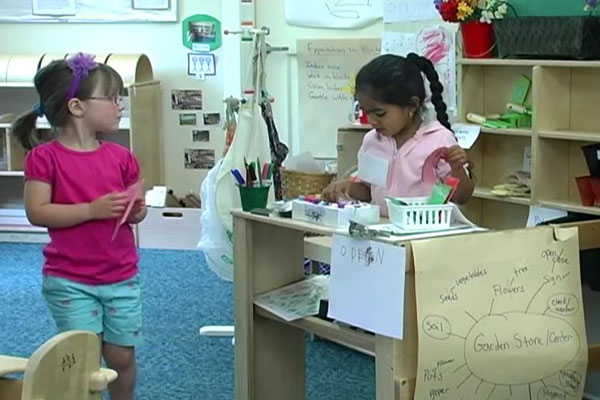The Garden Center: A Child-Created, Teacher Modeled Dramatic Play Center
Download a printable English trancsript or Spanish transcript.
Narrator: Play is important for all areas of development. When children are playing they learn social skills, they learn language, they exercise their large muscles, they create and they imagine. In play, children also learn about the world around them.
Dr. Jeffery Trawick-Smith, Eastern Connecticut State University: Teachers should give some thought to the kinds of themes that they focus on when they create a dramatic play center.
Cynthia DeJesús, Preschool Teacher: There are some challenges to gardening because preschoolers, as we know, have a difficult time waiting. It’s good for preschoolers because it involves a lot of hands-on activities: it can involve math and science and art. We have access to a garden in the back deck that I wanted the children to utilize. I’m not a gardener so this was a learning process for me as well. We started off just looking at seeds and talking about what a seed was, I had seeds out in different centers and then we grew a green bean out of a bean. Once the children had the idea what a seed can grow into we ended up walking to our back garden and seeing what we could do there. We took a walk that same day to the local garden store. It was a great hands-on experience for them to actually see something in their neighborhood that we can use for our garden. They need to build that background knowledge.
Cynthia: Remember when we went to our garden center? What did we see there? You just said it.
Child: Tree.
Cynthia: We did! We saw apple trees and pear trees, I can add that.
Cynthia DeJesús: That led us back into our gardening web of what we may need which led to our dramatic play center.
Cynthia: Let’s go over and see what we have so far and I want you to think of something if we are missing anything. So in our garden store you said we need flowers, trees, seeds…
Dr. Jeffery Trawick-Smith: Teachers often choose to use their dramatic play center as a way to help children explore more deeply some the concepts or the themes that they’re investigating in their classrooms.
Cynthia DeJesús: In our classroom the children are really heavily involved in the dramatic play center. They come up with the idea; they come up with the materials that we use in there. When we made our garden web of what we saw at the store, that’s what they thought they needed in our garden store.
Cynthia: What will we make for our store? I’ll let you think about it.
Child: Flowers.
Cynthia: More flowers. What kind of flowers will you make?
Cynthia DeJesús: Then we take that list that they compiled, then children make the items, so they make the flowers in the art center, in the writing center they’ll make the signs for the seed packets, they’ll make the price tags, they’ll make the cash register in the art area. Then they help set it up, and then they figure out, “Where should we put the gardening gloves, where we should put the pot, how will the customer know that’s a pot?” and then we’ll label it. So that takes a week or so, and then the grand opening.
Teacher: Green Room Garden Center…
Cynthia: Oh hi.
Teacher: Hello.
Cynthia: How are you this morning?
Teacher: I am very good, how are you?
Cynthia: Good, I was looking through a gardening magazine and I have my garden all ready, all the weeds are out, but I’m missing a few things, I was wondering if I can visit your store?
Cynthia DeJesús: I think it’s so important that teachers model how to use the center because although they were part of making the items they still don’t really know how to really use them.
Teacher: What was on your list?
Cynthia: Um, soil…
Teacher: Okay, right down here at the bottom we have bags of soil and mulch.
Cynthia: Okay.
Teacher: So which would you prefer for your garden?
Cynthia DeJesús: So I would take the part of the customer while another teacher can take the part of a clerk.
Cynthia: Perfect.
Teacher: You have all of your items.
Cynthia: I have all of my items.
Teacher: Okay, let me figure out how much that’s going to cost. That will be fifteen dollars.
Cynthia: Fifteen dollars, okay.
Cynthia DeJesús: They see that play, that they will be involved in and after you do it the children have the opportunity to go in there, they actually mimicked and did the same thing until it became their own and got the use of the materials and then it was more of themselves and not just modeling what we did.
Child 1: Sam, come here. What do you need?
Child 2: I need a shovel.
Child 2: Do you have a gardening glove? That’s on my list too.
Child 1: We don’t have so many gardening gloves.
Child 2: Those match. I’ll take those two.
Cynthia DeJesús: Going to places like the garden store before you make a dramatic play center in your classroom is important, it brings it more to life when they have, when they see it and then bring that experience back.



